Avifauna – Namib to Zambezi 2025 (Feb)
Avifauna Namib to Zambezi in February 2025, the guided birding tour with natural history specialities.
Namib, Etosha, Okavango, Chobe, Zambezi to Victoria Falls
This nature-guided small group tour places its emphasis on captivating wildlife observation, biodiversity, animal photography, and experiencing various species in diverse habitats amidst breathtaking landscapes. The carefully chosen accommodations for this journey all fall within the upscale category, strategically positioned to optimise access to key attractions. Each lodging boasts positive reviews, prioritises safety and cleanliness, undergoes thorough testing, and features private bathrooms.
Our aim is not only to showcase the main animal species but also to introduce you to various subspecies. Witnessing an elephant in an awe-inspiring desert landscape and observing them later along the banks of the Okavango River is a truly unique experience. By the end of the journey, you will not only have acquired knowledge about various zebra species but also about subspecies and variants found in different regions of Namibia.
The striking contrast between the arid semi-desert regions of Damaraland, the western and eastern sections of Etosha National Park, and the water-rich dry forests, marshlands, and rivers of the Okavango, Kwando, and Chobe in the Caprivi, along with the misty rainforest at Victoria Falls, reveals an impressive diversity of animals and plants. This diversity makes Namibia a truly unique destination in Africa!
This journey is designed not only for nature and animal enthusiasts but is also a paradise for photographers. We gladly delve into special interests like botany or ornithology along the way – providing a comprehensive and high-quality guidance, which Leaflove Safari is renowned for!
The carefully chosen accommodations for this journey all fall within the upscale category, strategically positioned to optimise access to key attractions. Each lodging boasts positive reviews, prioritises safety and cleanliness, undergoes thorough testing, and features private bathrooms.
The carefully chosen accommodations for this journey all fall within the upscale category, strategically positioned to optimise access to key attractions. Each lodging boasts positive reviews, prioritises safety and cleanliness, undergoes thorough testing, and features private bathrooms.
Upon closer inspection, rock hyraxes reveal their small tusks, while klipspringers can leap almost vertically up rock faces with their small “rubber hooves.” The ground squirrel found among the rocks is of a special species – the wildlife in Erongo is unique!
The gigantic granite boulders of Erongo are impressive, making visitors feel “dwarfed” among the towering rock walls of these magma mountains. Some legendary rock paintings, semi-endemic bird species, and a remarkable semi-desert flora, such as thick-stemmed grapevines and highly poisonous euphorbias, await hikers and walkers here.
Indigenous people have painted clear scenes of hunting and wildlife on the smooth granite walls. The landscape appears magical and offers beautiful photo opportunities.
The dry riverbed Huab and its tributary Awa-Huab carve their way through this geologically striking desert region in the visually stunning Damaraland.
Towering Ana trees, also known as “Winter Thorn Acacias,” line the banks, producing red pods favoured by desert-dwelling elephants. Engaging the 4×4, we navigate through the thick sand, tracing the footsteps of these magnificent creatures. Along the way, we admire herds of ostriches and springboks, inspect fascinating succulents, and eventually encounter the sought-after desert elephants. Coming across such nature in this semi-desert landscape leaves an unforgettable impression!
Noteworthy attractions include the 4,000 to 6,000-year-old petroglyphs at Twyfelfontein, the “burnt mountain,” and the basaltic “organ pipes.” Approximately 200 million years ago, enormous prehistoric “Cordaites” trees were washed in large mud floods from Central Africa and covered with muddy masses. With the absence of oxygen, petrification occurred, and these „fossilised trees” are now admired as remarkably peculiar geological formations.
2 nights at a well-located and beautiful lodge in the eastern area, directly adjacent to the park.
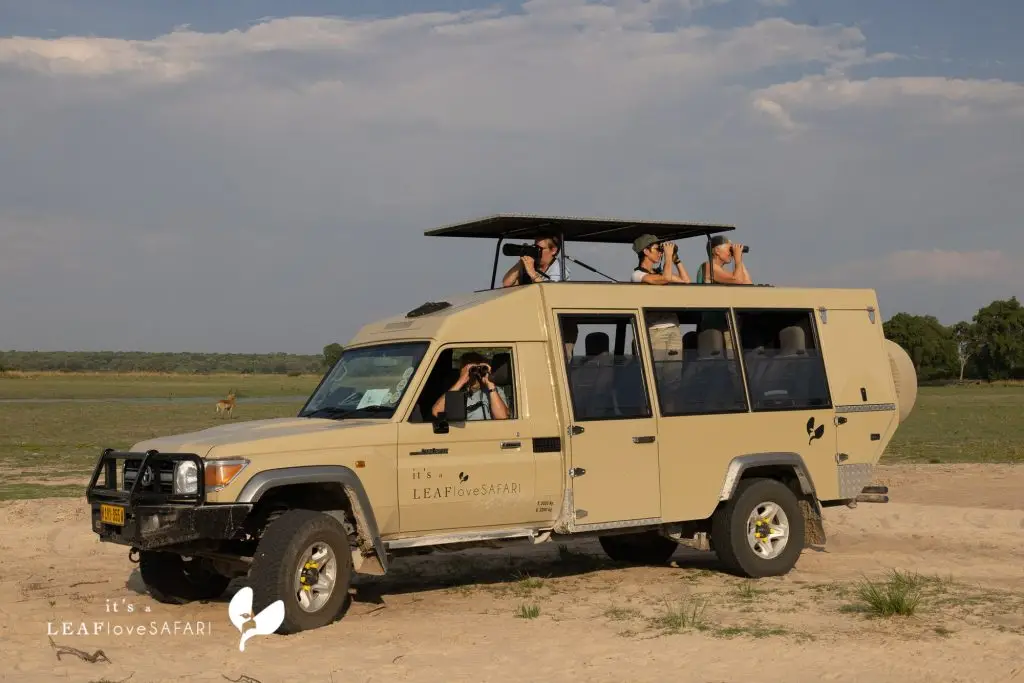
“The “Great White Place,” Etosha National Park, covers over 22,000 km² and is one of the wildlife-rich parks in Africa.
Spotting a lion by the roadside or encountering a herd of elephants is exciting, but one should be aware that this area presents a very arid landscape, where the wildlife must endure very harsh conditions.
The vast 4000 km² salt pan generates artesian springs on the southern shore, known as “contact springs.” Especially in slightly drier and warmer seasons, a plethora of diverse wildlife gathers here in abundance.”
The Etosha agama and the paradise crane pique our interest, as well as the impressive Makalani palms and very small Damara Dik-Dik antelopes. The diverse flora brings extensive biodiversity… So, you not only see many animals but also a variety of different ones!
The wildlife has lost its fear of vehicles, providing excellent opportunities for animal observation and photography. Along the way, you can find several antelope species such as springboks, black-faced impalas, wildebeests, klipspringers, steenbok, and rare black-nosed impalas. Predators like lions are often spotted, while leopards and cheetahs are a bit rarer. Pachyderms, including the rare black rhinoceros, the white rhinoceros, and elephants, also call this place home.
With our journey into the enchanting northeast, a chapter of ‘storybook Africa’ unfolds. Traditional huts of the Nyemba come into view, carrying the aromatic scent of !Girigu campfires. Chickens and cattle casually traverse the road, and the landscape gradually thickens with lush vegetation. The Kavango River, later to become the Okavango, stretches out before us.
Despite the modest size of Mahango Park, it hosts elusive antelopes like the roan, sable, and tsessebe, alongside the graceful presence of giraffes and the frequent passage of elephants. Lechwe, waterbuck, and reedbuck grace the shores of the Okavango.
The melodious call and majestic appearance of the fish eagle leave a lasting impression. Navigating the sandy trails of Mahango West, we encounter the distinctive Chapman’s zebra and occasionally chance upon small herds of buffalo. Our reliable vehicle grants us access to explore the eastern bank of the Okavango, specifically the Buffalo Core Area. Here, colossal gatherings of buffalo and elephants are a common sight, while our aspirations extend to spotting the splendid wattled cranes and, perhaps, African snipes in the southern marshy expanses of this region.
6 & 7.6.2025
The Kwando/Linyanti/Liambezi floodplain is a captivating landscape featuring broad stretches of reed and papyrus belts, interspersed with numerous lagoons and extensive floodplains along the river. This unique environment acts as a natural congregation point for a diverse array of wildlife. The waters are teeming with hippos, crocodiles, and Nile monitors.
A thriving population of various antelope species, the striking Chapman’s zebra, herds of buffalo, and numerous elephants can be spotted quenching their thirst along the Kwando’s banks. The wilderness offers enchanting experiences, from regular sightings of pythons to an increasing number of encounters with elusive leopards.
This untamed realm is also home to rare and beautiful species like the racket-tailed rollers and other great birds.
Known as ‘Painted Dogs’ by the English, we embark on independent excursions into this area, specifically seeking out the African wild dogs.
In Mudumo Park, our quest leads us to explore the Nakatwa Island region, offering a glimpse into a piece of the last untouched Africa.
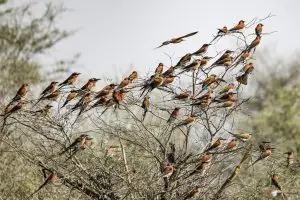
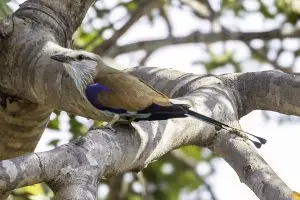
Today, we navigate the Chobe River, located at the intersection of Namibia, Zambia, Botswana, and Zimbabwe, boasting the densest wildlife population in Africa. Each year, the Chobe River floods numerous shallow islands for many kilometres. Life here flourishes, as there is an abundance of food for all.
The riverbanks are lined with numerous elephants, and you may even witness them swimming—an exquisite opportunity for photographers. The flat islands are grazed by buffaloes, impalas, the rare grass antelope ‘Puku,’ and waterbucks. Along the shore, Nile crocodiles lie in close proximity, creating wide-angle photo opportunities.
As you embark on a boat safari, flocks of various bird species, including African skimmers, whistling ducks, spur-winged geese, and many different bee-eaters, soar overhead. On the riverbanks, you’ll encounter squacco herons, and the black heron showcases its remarkable fishing technique by forming its wings into a bell shape. The guarantee of capturing kingfishers in action adds to the photographic allure!
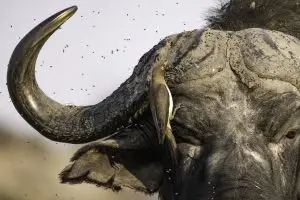
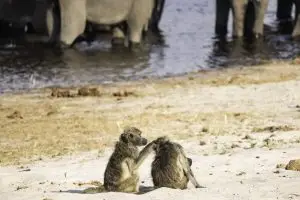
David Livingstone bestowed the name Victoria Falls upon this natural wonder, describing it as ‘a sight Angels must have gazed upon,’ capturing its breathtaking beauty. While not the tallest or widest, the falls’ combination of width and grandeur is truly remarkable.
Perpetual mist and rain create an ethereal atmosphere around Victoria Falls. A lush forest of fig trees, ferns, waterberries, and majestic baobab trees adorns the impressive riverbank. As you admire the fruits of Ficus sur, above you, the trumpeter hornbill indulges in the bountiful figs, and the Schalow’s turaco, with its striking red wings, calls out enthusiastically.
During a leisurely stroll, you’ll encounter various viewpoints, each offering a different perspective of the 108-meter-deep falls.
Zimbabwe is home to a vibrant artistic community, promising encounters with unique artworks and interesting individuals in this lively town.
Today, you’ll board one of the numerous connecting flights departing from Victoria Falls.
| Participants | Per Person |
|---|---|
| 2 Participants | 10.972,00 $ |
| 3 Participants | 8.889,00 $ |
| 4 Participants | 7.849,00 $ |
| 5 Participants | 7.223,00 $ |
| 6 Participants | 6.807,00 $ |
| 7 Participants | 6.512,00 $ |
| Single supplement | 720,00 $ |
Please get in touch with us. Unfortunately, our detailed route descriptions are now being peddled and we only like to disclose these details directly. We would be happy to send you the route with specific accommodation links.
If you are particularly interested in abundant wildlife, the months of May to September would be ideal. If you are a birder or botanist, you should contact us for September to April instead.
The risk of mosquito bites is significantly higher during the months of January to April and May. It’s essential to take precautions and protect yourself against mosquito bites during this period. From May to November, the risk decreases, but it’s still advisable to take preventive measures against mosquito bites and consider prophylaxis for added assurance.
Yes, please only check that your passport is valid for at least 6 months after your return and that there are at least 4 free pages available.
This Safari was last updated on 25. July 2024 @ 14:13.
Avifauna Namib to Zambezi in February 2025, the guided birding tour with natural history specialities.
Namib, Etosha, Okavango, Chobe, Zambezi to Victoria Falls
Diverse Namibia, a guided Safari through Namibia, where you’ll immerse yourself in the abundant wildlife and flora, as well as encounter numerous highlights of this remarkable country.
16 days – A condensed version packed with experiences of a classic yet high-quality Namibia tour, staying in fantastically located upscale accommodations that operate sustainably.